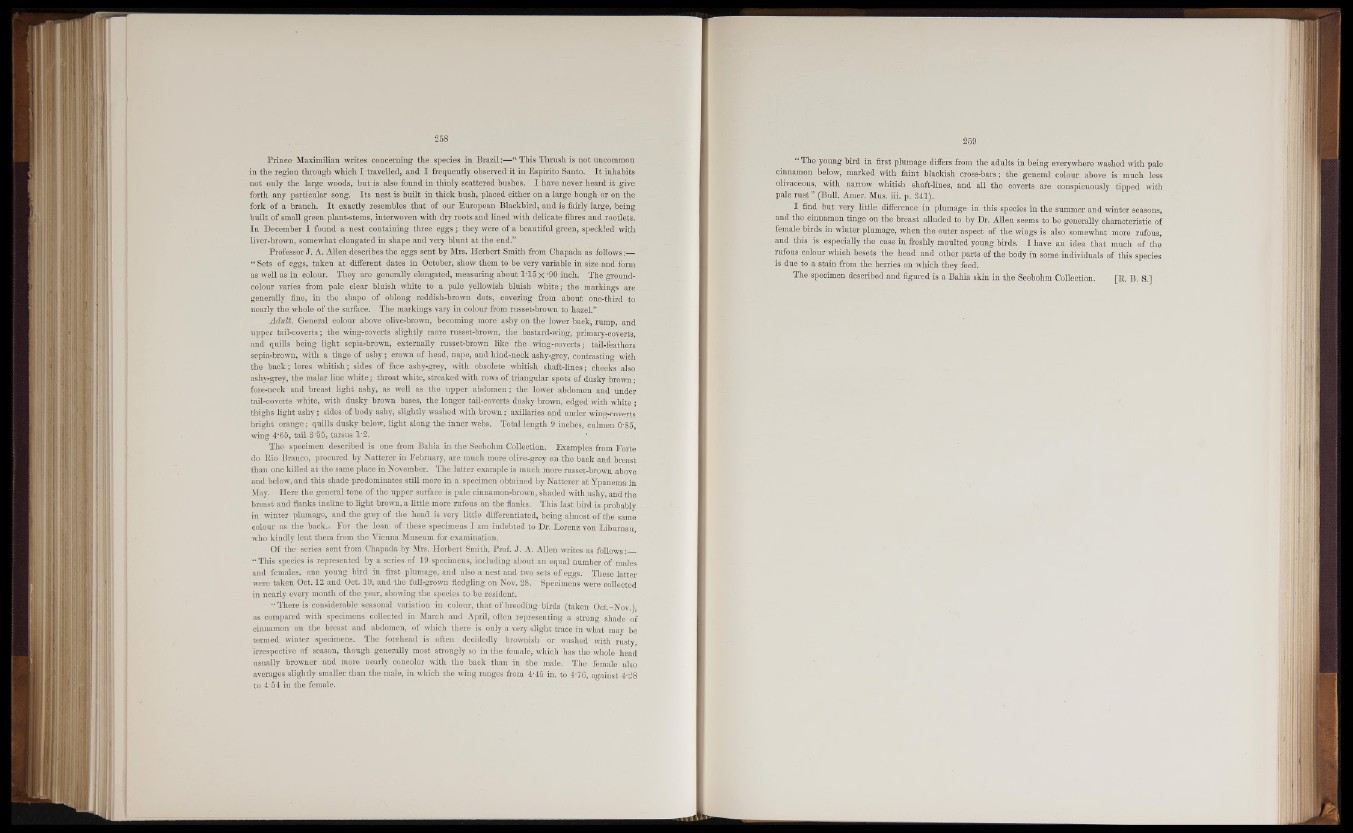
Prince Maximilian writes concerning the species in Brazil:—“ This Thrush is not uncommon
in the region through which I travelled, and I frequently observed it in Espirito Santo. It inhabits
not only the large woods, but is also found in thinly scattered bushes. I have never heard it give
forth any particular song. Its nest is built in thick bush, placed either on a large bough or on the
fork of a branch. It exactly resembles that of our European Blackbird, and is fairly large, being
built of small green plant-stems, interwoven with dry roots and lined with delicate fibres and rootlets.
In December I found a nest containing three eggs; they were of a beautiful green, speckled with
liver-brown, somewhat elongated in shape and very blunt at the end.”
Professor J. A. Allen describes the eggs sent by Mrs. Herbert Smith from Chapada as follows :—
w Sets of eggs, taken at different dates in October, show them to be very variable in size and form
as well as in colour. They are generally elongated, measuring about IT S X ’90 inch. The groundcolour
varies from pale clear bluish white to a pale yellowish bluish white; the markings are
generally fine, in the shape of oblong reddish-brown dots, covering from about one-third to
nearly the whole of the surface. The markings vary in colour from russet-brown to hazel.”
Adult. General colour above olive-brown, becoming more ashy on the lower back, rump, and
upper tail-coverts ; the wing-coverts slightly more russet-brown, the bastard-wing, primary-coverts,
and quills being light sepia-brown, externally russet-brown like the wing-coverts ; tail-feathers
sepia-brown, with a tinge of ashy ; crown of head, nape, and hind-neck ashy-grey, contrasting with
the back; lores whitish; sides of face ashy-grey, with obsolete whitish shaft-lines; cheeks also
ashy-grey, the malar line white ; throat white, streaked with rows of triangular spots of dusky brown ;
fore-neck and breast light ashy, as well as the upper abdomen ; the lower abdomen and under
tail-coverts white, with dusky brown bases, the longer tail-eoverts dusky brown, edged with white ;
thighs light ashy ; sides of body ashy, slightly washed with brown ; axillaries and under wing-coverts
bright orange; quills dusky below, light along the inner webs. Total length 9 inches* culmen 0?85,
wing 4*65, tail 3*55, tarsus 1*2.
The specimen described is one from Bahia in the Seebohm Collection. Examples from Forte
do Rio Branco, procured by Natterer in February, are much more olive-grey on the back and breast
than one killed at the same place in November. The latter example is much more russet-brown above
and below, and this shade predominates still more in a specimen obtained by Natterer at Ypanema in
May. Here the general tone of the upper surface is pale cinnamon-brown, shaded with, ashy, and the
breast and flanks incline to light brown, a little more rufous on the flanks. This last bird is probably
in winter plumage, and the grey of the head is very little differentiated, being almost of the samé
colour as the back.« For the loan of these specimens I am indebted to Dr. Lorenz von Liburnau
who kindly lent them from the Vienna Museum for examination.
Of the series sent from Chapada by Mrs. Herbert Smith, Prof. J. A. Allen writes as follows :__
“ This species is represented by a series of 19 specimens, including about an equal number of males
and females, one young bird in firstxplumage, and also a nest and two sets of eggs. These latter
were taken Oct. 12 and Oct. 19, and the full-grown fledgling on Nov. 28. Specimens were collected
in nearly every month of the year, showing the species to be resident.
“ There is considerable seasonal variation in colour, that of breeding birds (taken Oct.-Nov.),
as compared with specimens collected in March and April, often representing a strong shade of
cinnamon on the breast and abdomen, of which there is only a very slight trace in what may be
termed winter specimens. The forehead is often decidedly brownish or washed with rusty,
irrespective of season, though generally most strongly so in the female, which has the whole head
usually browner and more nearly concolor with the back than in the male. The female also
averages slightly smaller than the male, in which the wing ranges from 4-45 in. to 4*76, against 4-28
to 4 54 in thè female.
The young bird in first plumage differs from the adults in being everywhere washed with pale
cinnamon below, marked with faint blackish cross-bars; the general colour above is much less
olivaceous, with narrow whitish shaft-lines, and all the coverts are conspicuously tipped with
pale rust ” (Bull. Amer. Mus. iff. p. 341).
I find but very little difference in plumage in this species in the summer and winter seasons,
and the cinnamon tinge on the breast alluded to by Dr. Allen seems to be generally characteristic of
female birds in winter plumage, when the outer aspect of the wings is also somewhat more rufous,
and this is especially the case in freshly moulted young birds. I have an idea that much of the
rufous colour which besets the head and other parts of the body in some individuals of this species
is due to a stain from the berries on which they feed.
The specimen described and figured is a Bahia skin in the Seebohm Collection. [R. B. S.]